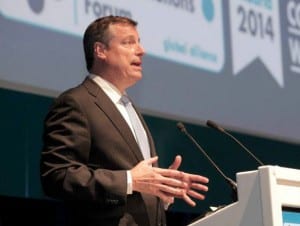 Rob Flaherty, our Chief Executive Officer & President, recently sat down for a Q&A with U.K.-based magazine PR Moment to discuss how research and data can improve the creative process.
Rob Flaherty, our Chief Executive Officer & President, recently sat down for a Q&A with U.K.-based magazine PR Moment to discuss how research and data can improve the creative process.
The relationship between creativity and data in public relations is an interesting one. Data analytics is improving the effectiveness of PR. But what is the impact of data on ideas and creativity?
It is obvious that data can help amplify a campaign once it is up and running by giving insight into what is working and what isn’t, but I’m more sceptical of the extent to which data has a useful impact on the conception of an idea.
I recently caught up with Rob Flaherty, Senior Partner, Chief Executive Officer & President at Ketchum, to discuss what the impact of data was at the inception of an idea. This is part of a series of interviews to celebrate the launch of PR Jobs London.
Ben Smith: Rob – how do you see the role of data in improving creativity?
Rob Flaherty: The combination of research and data informed insight with a tremendous amount of your own personal insight and creativity brings about the best creative ideas.
Research suggests that a lot of the assumptions people make because of primacy and “recentsy” of their own experience are frequently flawed. The use of data is so important to get to the best insights, you need that left brain/right brain combination to bring about the highest quality work.
BS: So PR teams need a combination of creative minds and analytic minds?
RB: We’re focused on ramping up both. Now that we get to play in the larger world of integrated marketing and premium content and in the scrum between ad agencies and premium shops – we have to raise the creativity bar.
The bit that has been understated so far has been the data side, the science side of the business. [In PR] we tend to hire people with great liberal arts backgrounds who are great writers, well-spoken and creative, but we also need to significantly ramp up the data/geeks recruitment. I have two kids, a daughter who is a liberal arts major with a degree in psychology and she is going into PR, my son is an engineer, he is a maths geek, but I’d like to be able to see them both go into our business.
BS: What does your son think of that? (Laughs)
RF: He’s staying in engineering.
BS: That’s an interesting debate isn’t it? There is still more money in engineering – PR doesn’t pay enough to attract those top mathematical brains.
RF: Yes but that’s changing. Over time you’ll see better pay for data geeks. We have a director of predictive analytics in the business, we have behavioural economists, and those are becoming hot jobs in PR.
BS: They are good jobs in PR already aren’t they? There is not even a hint of shame in being a data guru in PR now?
RF: I think there used to be. But I look forward to a time when everyone in the firm comes in in the morning with an excitement to view the overnight analytics on their dashboard to see the results of their hard work the day before, so that they can see what they need to dial up and dial down over the course of the day.
BS: Everyone can be creative can’t they? It’s a question of knowledge, state of mind and intelligence isn’t it?
RF: I would say that it’s more about how much creativity has been knocked out of you. The analogy is – colour inside the lines. That’s drilled into us from four years old – and it’s a shame. The limiting factor is how much of a conformist have you become over the first 20 years of your life.
BS: What about data – to what extent can we all embrace data?
RF: I used to say I need all of our employees to find their inner geek, but the more I work with our data experts the more they will tell me that we need to make data something that anyone can use. So it’s not that we need the majority of people to understand the deep data, we just need them to understand the implications of the data.
BS: Sure – your job is to give your people a data dashboard.
RF: Yes, my job is to make the data easy so that Ketchum’s people can use it
BS: Just going back to the data: creativity juxtaposition – in practical terms – is the role of data to test the creative or find the creative?
RF: The line I like is “let’s not try to use data the way a drunk uses a lamppost – for support instead of illumination.” Don’t use it to post rationalise what you are about to recommend. Actually use it as a path to get to a better, richer human insight.
The insight is the most powerful part – even more so than the data, or the creative or the content. I would take a campaign that has a game changing insight over the data and the creative any day – because it’s the insight itself that can make that fundamental change.
BS: What gives people great insight? Is it experience or is it fresh thinking?
RF: You can’t make someone who is creatively a 4/10 into a 10/10 but you can make them a 6/10. You can elevate everyone through training.
But it’s important to understand what a real insight is. The fact that working women are busy is not a real insight. The push to use focus groups and panels to get to something that is game changing, new and fresh is vital. And teaching people the difference between lame, everyday insight and one that’s going to really make a difference is important.
BS: Are there not two levels of creativity in public relations? There is the campaign creative that sets the agenda, and from this content will flow. But there is also the day-by-day, hour-by-hour creativity that enables PR people to respond to news themes and ideas in the market.
RF: There are people that have dedicated their careers to being absolutely brilliant creatives. But increasingly there is this real-time marketing of brands and a 24-second news cycle that requires a massive level of creativity on a minute-by-minute basis.
This is something that we call the story lab. It’s a content engine, a content management system for clients that are turning out content on a daily basis or tracking memes about their brands. And I do think that it is something that PR businesses do better than ad agencies and marketing agencies.
BS: Absolutely, the day-to-day contact that PR agencies have with their clients, frankly, gives them an unfair advantage when it comes to that type of creativity over ad agencies and digital agencies.
RF: Right, and also we’re not always trying to monetise every campaign through paid media. We’re increasingly doing paid amplification on an hour-by-hour basis, but our win is not always going to be the giant creative campaign that manifests itself as a 30-second spot that costs $100m to run.
BS: No, PR is not going to win that game.
RF: Exactly, but what we can win at is the far more interesting and more impactful one that recognises the cost for content has come down, the cost of distribution is virtually zero and clients appreciate the efficiency of our response .
All research still shows that something that is shared from one person to another and that is less branded has more impact on people than something that is heavily branded and appears in a paid ad.
BS: How can we get more creative people in public relations?
RF: We’re getting a lot of people from the ad and digital worlds. Any form of creative enterprise – movie studios, any place where great creative people are – that’s where we’re going!
BS: We’ve seen some great creativity in consumer PR for a while now but, often, these campaigns have struggled to take what is in essence a media relations creative and amplify it into an integrated campaign.
RF: Right, which is how we frame one of the things we want to accomplish at Ketchum. We want to be the source of the campaign leading idea. It’s a high bar; it doesn’t mean we’ve failed if we don’t achieve it. I always say that if you’re in a brainstorm now, if you think you are trying to come up with the greatest PR idea – stop. Come up with the campaign leading idea – one that we are all ridiculously envious of.



